46 Yellow Flowering Trees (with Pictures): Identification Guide

Yellow flowering trees bring a burst of bright sunshine to any garden landscape. With their bright and cheerful blooms, trees with yellow flowers enhance a yard’s aesthetics and fill summer landscapes with sweet fragrances. Whether you’re looking for a small ornamental tree like a golden wattle, golden rain tree, or yellow bells, or a larger yellow-flowering shade tree like a tulip tree, plenty of options are available.
Landscaping trees with yellow flowers are generally easy to maintain and grow in residential gardens. Many evergreen yellow-flowering trees thrive in tropical or warm climates, blooming throughout the year. On the other hand, numerous deciduous trees with yellow flowers suit temperate climates, filling front or backyards with bright golden yellow colors from spring through fall.
This article is an identification guide to yellow flowering trees. Descriptions and pictures of the different types of trees with yellow blooms will help you identify and choose the best trees to add vibrant color to your garden landscape.
Yellow Flowering Trees: Identification Guide with Pictures
Magnolia Butterfly tree (Magnolia ‘Butterflies’)
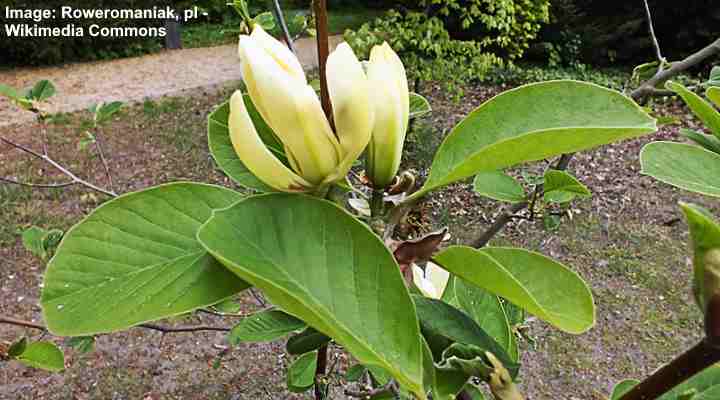
The magnolia butterfly tree is a stunning yellow-flowering tree that adds beauty and elegance to any landscape. This small deciduous tree produces large, fragrant, canary-yellow, cup-shaped flowers in early spring. The lemon-scented flowers appear on bare branches before the dark green leaves emerge.
Magnolia butterfly trees are known for their upright, pyramidal shape and glossy green leaves. The relatively small tree is suitable for planting in smaller gardens as a specimen plant, border plant, or flowering hedge. The magnolia butterfly tree is a perfect choice to add a touch of color and elegant beauty to a garden landscape.
Mature Size: 25 to 30 ft. (7.5 – 9 m) tall and 10 to 15 ft. (3 – 4.5 m) wide
USDA Hardiness Zones: 5 to 9
Sun: Full sun to partial shade
Cucumber Tree’ Yellow Bird’ (Magnolia acuminata ‘Yellow Bird’)

In late spring, the ‘Yellow Bird’ magnolia cultivar produces fragrant bright yellow tulip-like flowers. The eye-catching golden flowers contrast nicely with the tree’s lush foliage. A feature of the cucumber tree is its long cucumber-shaped fruits that turn from green to reddish-brown in the fall, hence its name.
Native to eastern North America, cucumber trees are best suited to medium-sized or larger landscapes. The tree’s pyramidal crown, stunning yellow blossoms, and long cylindrical fruits make it a beautiful ornamental shade tree. Cucumber trees prefer well-drained, organically rich, moist soil. The tree’s attractive flowers and unique fruit make it a standout addition to any garden or landscape.
Mature Size: 40 to 70 ft. (12 – 21 m) tall and 20 to 30 ft. (6 – 9 m) wide
USDA Hardiness Zones: 4 to 8
Sun: Full sun to partial shade
Magnolia Tree ‘Elizabeth’ (Magnolia ‘Elizabeth’)
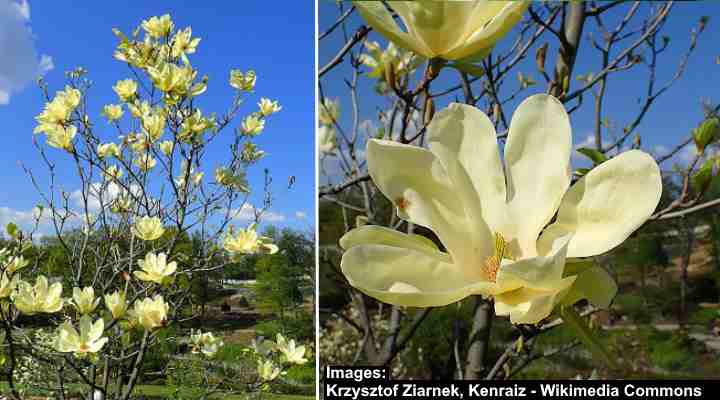
The magnolia tree ‘Elizabeth’ is a stunning ornamental tree with pale yellow, fragrant flowers. The early spring blooming tree adds elegance to any landscape. Its pyramidal crown, yellow cup-shaped flowers with a tinge of green, lush, showy leaves, and cone-like red fruits are attractive features. The yellow flowers bloom as the green leaves unfurl.
The ‘Elizabeth’ magnolia tree is compact, ideal for creating a focal point in small to medium-sized landscapes. You can also grow the yellow-flowering tree as a specimen plant or shade tree. It thrives in slightly acidic, organically rich soil that drains well.
Mature Size: 20 to 35 ft. (6 – 10.6 m) tall and 12 to 20 ft. (3.6 – 6 m) wide
USDA Hardiness Zones: 5 to 8
Sun: Full sun to partial shade
Golden Shower Tree (Cassia fistula)
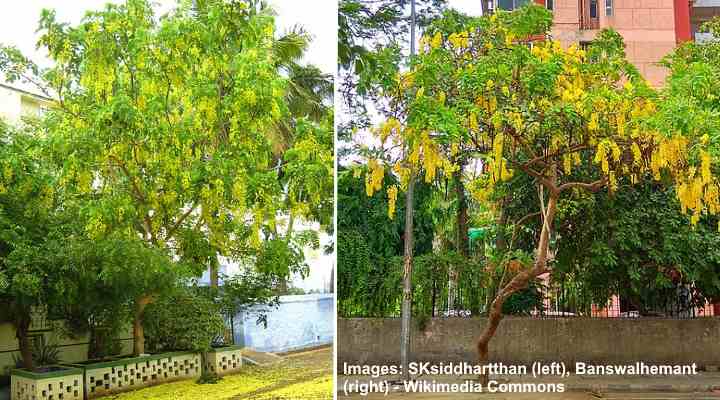
Golden Shower Tree (Cassia fistula)
The golden shower tree is a stunning ornamental shade tree producing cascading clusters of yellow flowers. The abundant golden flowers bloom in late spring through summer, creating an effect of a bright yellow golden shower of blossoms covering the tree. After flowering, woody seed pods emerge and persist on the tree until the following spring.
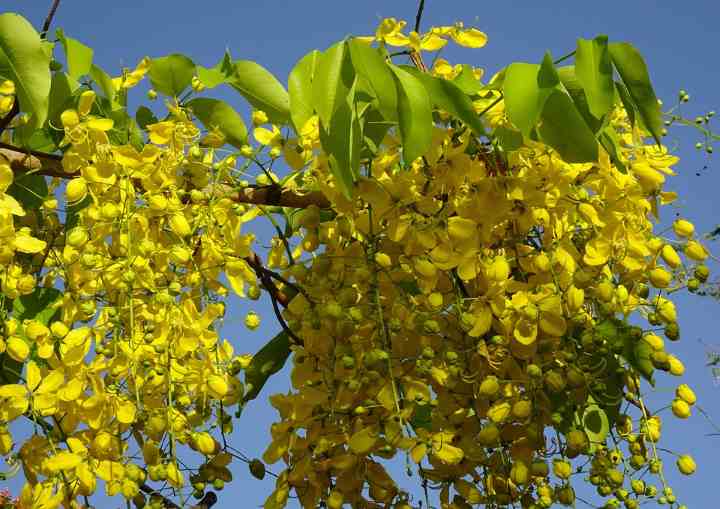
Cassia fistula
The golden shower tree is native to tropical and subtropical regions and thrives in well-drained soil. It is a fast-growing tree with plenty of decorative value for medium to large landscapes. The tree’s vibrant yellow flowers attract pollinators such as butterflies and bees, adding extra beauty to your garden.
Mature Size: 30 to 50 ft. (9 – 15 m) tall and wide
USDA Hardiness Zones: 10 to 12
Sun: Full sun
Golden Trumpet Tree (Tabebuia chrysotricha or Handroanthus chrysotrichus)
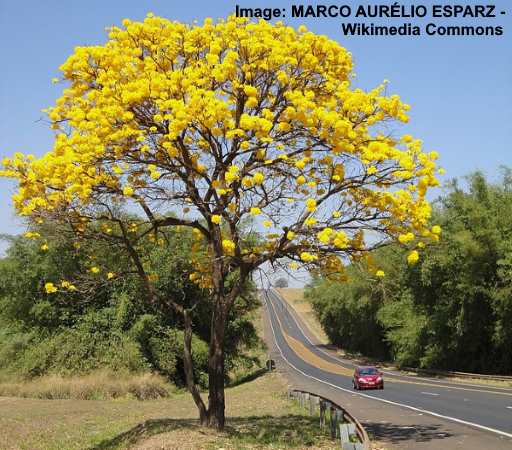
The golden trumpet tree is a stunning yellow-flowering small to medium tree with vibrant yellow funnel-shaped flowers. The spectacular ornamental tree blooms in spring, covering the tree in beautiful clusters of yellow flowers. Other identifying features of the golden trumpet tree are its long dangling seed pods and silvery leaves with fuzzy undersides.
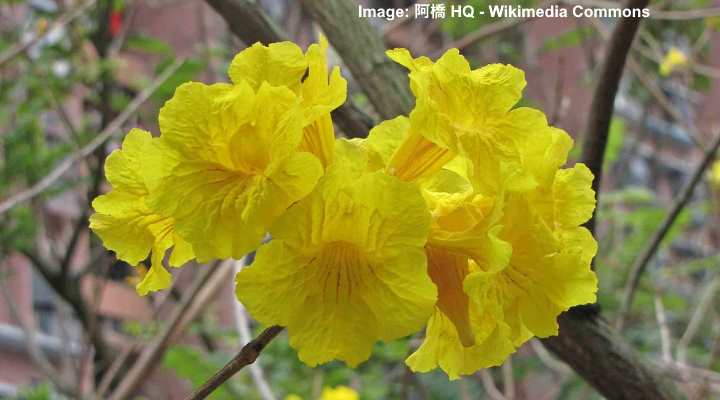
Native to South America, the golden trumpet tree thrives in tropical and subtropical climates. It performs well in most soil types that are well-draining. The yellow-flowering tree is popular in Florida as a shade tree, specimen plant, or lawn tree. It’s also great for attracting native pollinators such as bees and butterflies.
Mature Size: 25 to 35 ft. (7.6 – 10.6 m) tall and wide
USDA Hardiness Zones: 10 to 11
Sun: Full sun
Yellow Poui (Tabebuia ochracea)

The yellow poui is a stunning ornamental tree with vibrant yellow trumpet-shaped flowers. Blooming in early spring, clusters of bright yellow flowers cover the branches, complementing the tree’s lush green foliage. The yellow poui is suitable for growing in coastal landscapes due to its tolerance for salt spray.
Yellow poui trees prefer well-drained soil and full sun. They are drought-tolerant once established and can thrive in a variety of soil types. Planting a yellow poui tree in your southern garden will add a burst of golden sunshine colors and beauty to your landscape.
Mature Size: Up to 35 ft. (10.6 m) tall and 30 ft. (10 m) wide
USDA Hardiness Zones: 10 to 11
Sun: Full sun
Pau D’Arco (Handroanthus serratifolius)
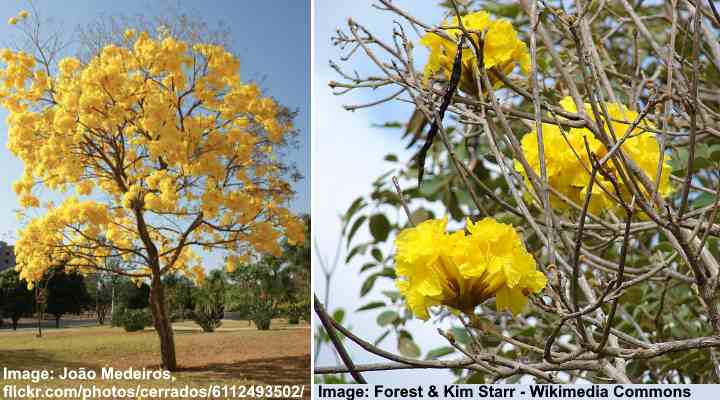
Pau d’Arco, the yellow lapacho tree, is a stunning yellow-flowering tree that adds bright yellow colors to sunny landscapes. The ornamental tree produces large, trumpet-shaped flowers in bright shades of yellow. The flowers bloom in clusters, creating a vibrant display of color and contrasting with the glossy green oval leaves.
Pau d’Arco trees are drought-tolerant and thrive in many soil types, including clay, loam, and sandy soils.
Thanks to their ornamental value, pau d’Arco trees are stunning shade trees that create an attractive habitat for wildlife. Also, their dense foliage makes the decorative trees ideal for windbreaks or privacy screens.
Mature Size: 25 to 40 ft. (7.6 – 12 m) tall
USDA Hardiness Zones: 9 to 11
Sun: Full sun
Candelabra Tree (Senna didymobotrya)
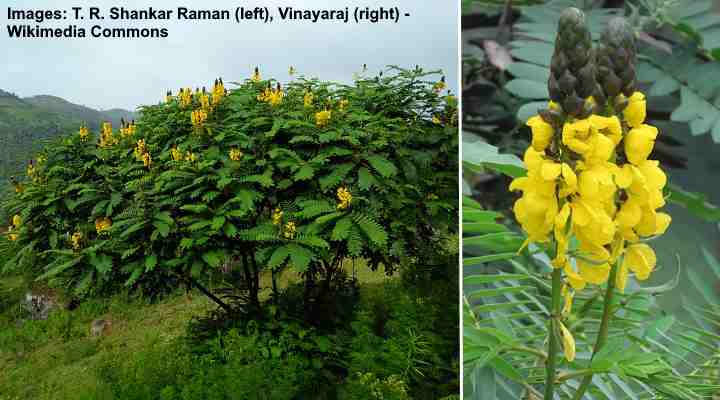
The candelabra tree is a small tree with vibrant yellow flowers. Also called the popcorn tree or peanut butter cassia, the ornamental tree has conical clusters of bright yellow flowers, large oval leaves, and long bean-like seed pods. Its golden flowers emit scents like burnt popcorn, peanut butter, or a wet dog.
Yellow-flowering candelabra trees thrive in warm, humid climates. Performing best in well-drained fertile soil, the sun-loving tree grows as an ornamental tree or accent in small or large landscapes. Its attractive yellow flower clusters add a burst of color and attract pollinators like butterflies and bees.
Mature Size: Up to 16 ft. (5 m) tall
USDA Hardiness Zones: 9 to 11
Sun: Full sun
Golden Wonder Tree (Senna spectabilis)
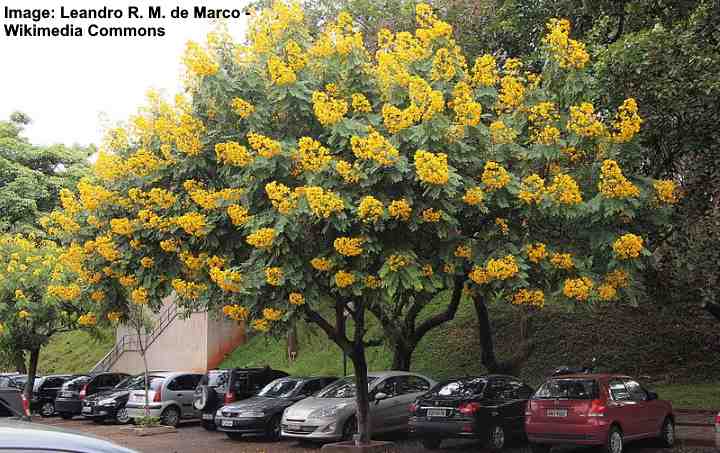
The golden wonder tree is a small ornamental tree with abundant clusters of bright yellow flowers. Its golden flower clusters measure up to 20” (50 cm) long and cover the tree throughout summer, creating a stunning floral display. Its fern-like foliage consists of pinnately-compound leaves measuring up to 3” (7.5 cm).
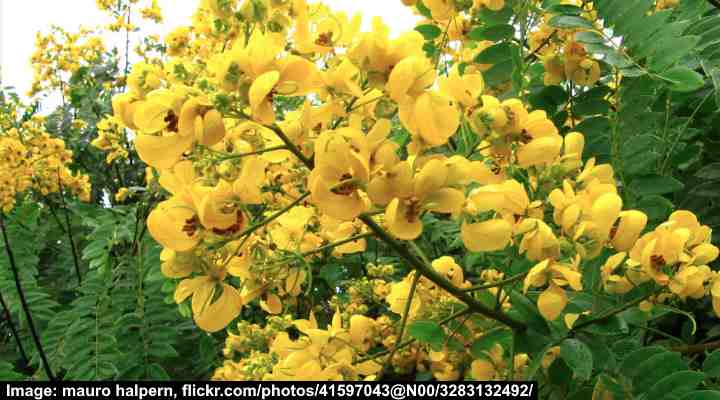
Thanks to its ornamental value and beautiful golden yellow flowers, the golden wonder tree looks stunning in front yards or as a shade tree in southern backyards. The attractive tree has rapid growth, drought, and heat tolerance and thrives in most soil types. It’s ideal as a yellow-flowering tree in tropical gardens.
Mature Size: 15 to 20 ft. (4.5 – 6 m) tall and wide
USDA Hardiness Zones: 9 to 11
Sun: Full sun
Yellow Flamboyant Tree (Peltophorum pterocarpum)
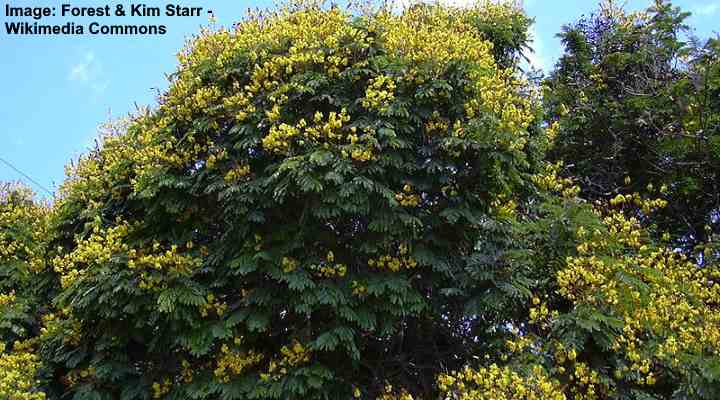
The yellow flamboyant tree is a stunning ornamental plant that produces bright yellow flowers on long flowering stalks. When blooming in spring and summer, the showy yellow flower clusters cover the tree. The flamboyant tree’s fern-like feathery foliage adds to its tropical appeal in sunny landscapes. The tree also produces long red seed pods measuring up to 4” (10 cm) long.
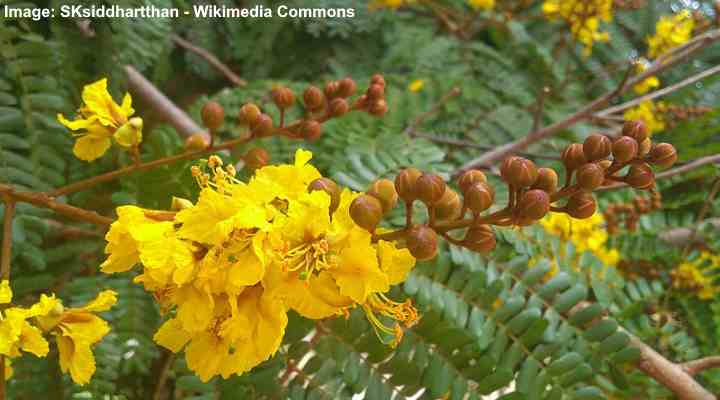
Known as the yellow poinciana, yellow flametree, or copperpod, the yellow flamboyant tree is a popular ornamental tree in warm climates. It is a low-maintenance tree that works well as a specimen plant or creates a focal point in large garden landscapes.
Mature Size: 50 to 82 ft. (15 – 25 m) tall and wide
USDA Hardiness Zones: 10 to 12
Sun: Full sun
Cornelian Cherry (Cornus mas)

The Cornelian cherry is a small decorative bushy tree that blooms in early spring with clusters of bright yellow flowers. The vibrant yellow flowers add a burst of color to spring landscapes as they appear on bare branches. The tree’s foliage is dark green, with oval leaves and bright red berries appearing in midsummer.
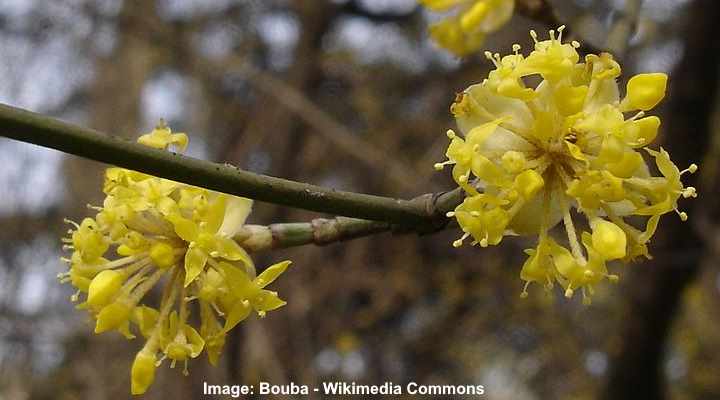
Cornelian cherry trees are adaptable and can tolerate a wide range of soil conditions. You can plant them as ornamental trees, hedges, privacy screens, or specimen plants. The tree’s attractive yellow flowers and edible red fruits make it a popular choice for adding visual interest to landscapes.
Mature Size: 15 to 25 ft. (4.5 – 7.6 m) tall and 21 to 20 ft. (3.6 – 6 m) wide
USDA Hardiness Zones: 5 to 8
Sun: Full sun to partial shade
Golden Chain Tree (Laburnum anagyroides)
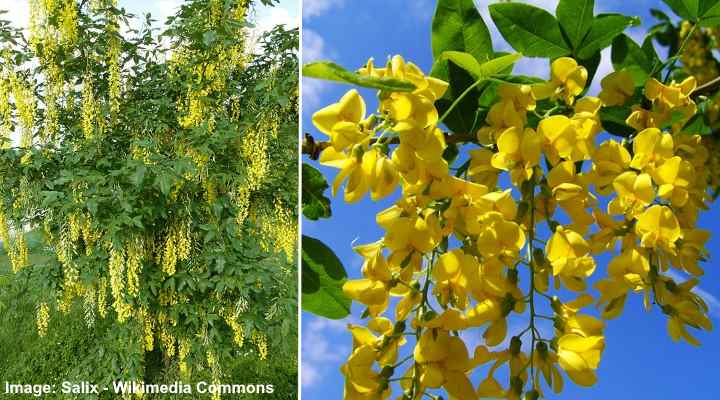
The golden chain tree is a small deciduous tree prized for its cascading clusters of bright yellow flowers. The pendulous chains of flowers hang down from the branches, creating a stunning display of color. The tree’s trifoliate leaves are bright green, and it has long flattened seed pods.
Golden chain trees are ideal yellow-flowering ornamental trees for temperate climates. Its primary use in a landscape is for its breathtaking floral display of dangling yellow flower clusters. You can also plant it as an accent plant in urban landscapes to attract pollinators.
It’s good to note that the golden chain tree is poisonous; therefore, you should take care when planting the tree near where children or pets play.
Mature Size: 15 to 25 ft. (4.5 – 7.6 m) tall and wide
USDA Hardiness Zones: 5 to 7
Sun: Full sun to partial shade
Weeping Scotch Laburnum (Laburnum alpinum ‘Pendulum’)
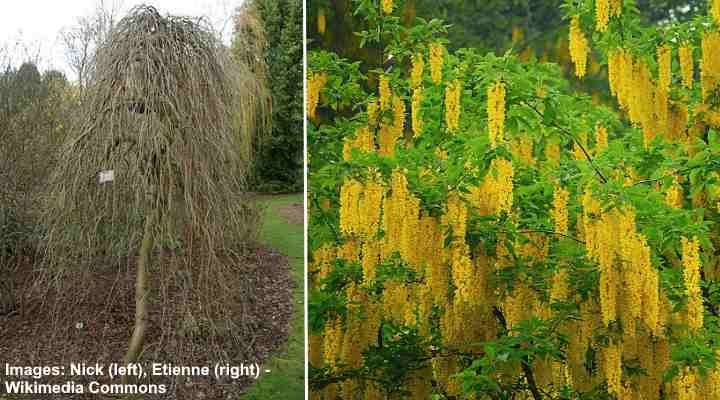
The weeping scotch laburnum is ideal if you are looking for a decorative weeping tree with yellow flowers. This stunning tree has cascading branches covered in small fragrant flowers. Its weeping habit, light green foliage, and long-blooming yellow flowers make it a spectacular ornamental tree in temperate climates.
The hardy ornamental weeping tree thrives in most soil types that drain well. The tree doesn’t take up much room in small gardens thanks to its pendulous branches and yellow flowers. This makes it ideal for planting as a specimen tree in small yards, tight spaces, or enhancing your front yard’s curb appeal.
Mature Size: 6.5 to 8 ft. (2 – 2.5 m) tall and up to 6.5 ft. (2 m) wide
USDA Hardiness Zones: 5 to 7
Sun: Full sun or partial shade
Yellow Flowering Camellia Tree (Camellia)
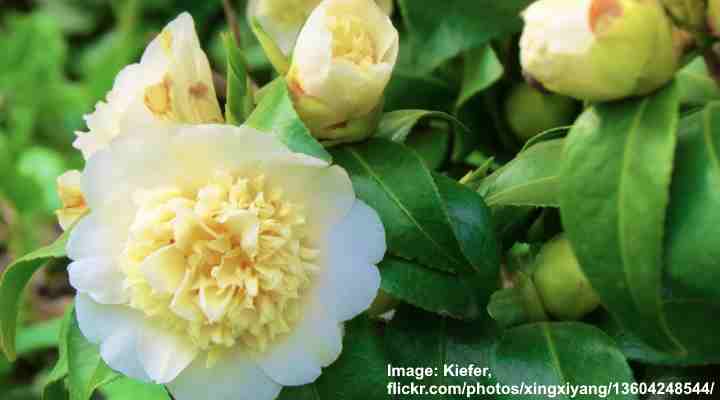
Yellow flowering camellia trees bloom with showy yellow flowers contrasting with dark, glossy green foliage. Evergreen camellia trees are known for their spectacular large flowers, many of which have ruffled double blooms. The trees produce abundant pale yellow flowers in early spring, providing a burst of color when many other plants remain dormant.
Yellow camellia trees prefer acidic, well-drained soil and partial shade to full sun. You can plant them to create a focal point in gardens or as a hedge to create privacy. With their beautiful flowers and glossy evergreen leaves, camellia trees add elegance and charm to any outdoor space.
Mature Size: 10 to 13 ft. (3 – 4 m) tall and 5 to 10 ft. (1.5 – 3 m) wide
USDA Hardiness Zones: 7 to 10
Sun: Partial shade
Yellow Oleander (Cascabela thevetia)

The yellow oleander is a small evergreen tree known for its beautiful yellow trumpet-shaped flowers. This attractive tree thrives in warm climates, and its showy yellow flowers bloom from summer through fall. The tropical tree has willow-like linear leaves. Dark red-black seed pods add to the tree’s attractiveness in late summer and fall.
Despite its ornamental appeal, it’s important to note that all parts of this tree are toxic if ingested. Therefore, it should be planted with caution, especially in areas where children or pets may be present. However, it remains popular as a small low maintenance ornamental tree in parks and gardens.
Mature Size: Up to 8 ft. (2.4 m) tall and 4 ft. (1.2 m) wide
USDA Hardiness Zones: 8 to 10
Sun: Full sun to partial shade
Lilac ‘Primrose’ (Syringa vulgaris ‘Primrose’)
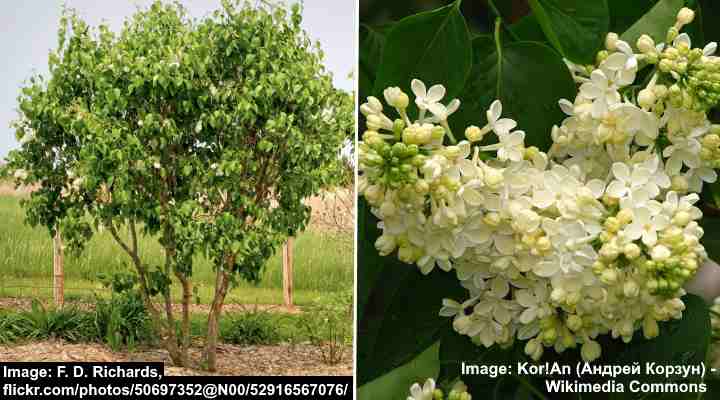
The lilac ‘Primrose’ is a beautiful pale yellow-flowering shrub you can train to grow as a tree. In late spring, the upright deciduous tree-like shrub blooms with spectacular conical clusters of fragrant, pale creamy-yellow flowers. These eye-catching pale yellow flowers bloom for four weeks, attracting butterflies and bees and enhancing a garden’s aesthetics.
The lilac tree ‘Primrose’ has green, heart-shaped leaves that turn yellow in the fall, adding a splash of autumn colors to your garden. It is a low-maintenance shrub that is easy to grow in well-drained soil.
For its dramatic spring blooms, you can plant yellow-flowering lilac as a flowering hedge, foundation planting, or perennial border.
Mature Size: 10 to 12 ft. (3 – 3.6 m) tall and wide
USDA Hardiness Zones: 4 to 7
Sun: Full sun to partial shade
Yellow Bells (Tecoma stans)

One of the most outstanding yellow-flowering trees is the yellow bells, also called the yellow trumpet flower. This beautiful shrub-like tree produces clusters of brightly colored yellow funnel-shaped tubular flowers. The vibrant yellow flowers cover the tree continuously from spring until the first frost, creating a stunning display throughout the season.
The ornamental tree is native to Texas, Florida, and New Mexico. It’s heat and drought-tolerant and can withstand dry, desert conditions, making it perfect for brightening xeriscape gardens. The tree is also relatively low-maintenance and can be pruned to maintain its desired shape and size.
Mature Size: 10 to 25 ft. (3 – 7.5 m) tall and wide
USDA Hardiness Zones: 9 to 11
Sun: Full sun or partial shade
Tulip Tree (Liriodendron tulipifera)
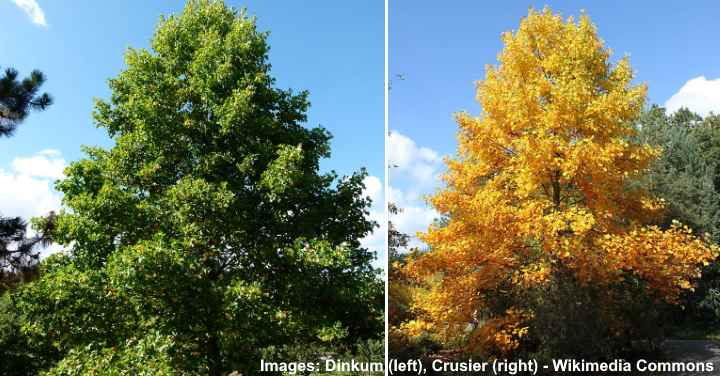
Tulip poplar trees – summer and autumn foliage
The tulip tree is a large deciduous tree that produces unique tulip-shaped yellowish-green. The cup-like, upward-facing flowers are yellow with hints of orange and green and bloom in late spring to early summer. The tulip tree has beautiful foliage consisting of four-lobed leaves and cone-like fruit. It has superb yellow foliage in the fall.

Tulip trees are fast-growing and can reach impressive heights, making them perfect shade trees. These ornamental trees have an oval, rounded crown that provides four-season interest thanks to their showy flowers, glossy foliage, and brown, conical fruits.
Mature Size: 60 to 80 ft. (18 – 24 m) tall and 30 to 40 ft. (9 – 12 m) wide
USDA Hardiness Zones: 4 to 9
Sun: Full sun
Yellow African Tulip Tree (Spathodea campanulata ‘Aurea’)
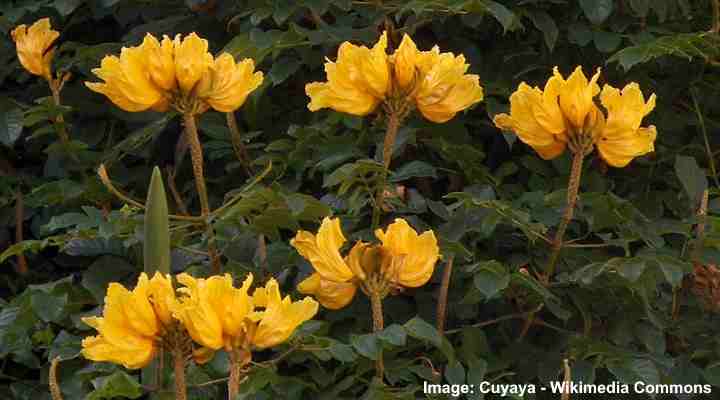
The yellow African tulip tree is fast-growing with large, cup-shaped yellow flowers. The flowers bloom in showy clusters, creating a striking display of yellow color against the tree’s dark green foliage. The tropical evergreen tree has an upright, rounded canopy that creates shade in hot, humid climates.
The yellow African tulip tree has moderate to high salt tolerance and moderate water requirements.
Mature Size: 52 – 75 ft. (16 – 22 m) tall and 15 to 25 ft. (4.5 – 7.6 m) wide
USDA Hardiness Zones: 10 to 12
Sun: Full sun
Kousa Dogwood (Cornus kousa)

The kousa dogwood is a small, deciduous tree that produces beautiful star-shaped golden-yellow flowers. Blooming in spring, flowers consist of yellowish-white bracts surrounding a small cluster of green flowers. The ornamental tree’s leaves are ovate and have an eye-catching purple, lavender, or burgundy fall color.
The dogwood also produces small fruits—edible red drupes that ripen in late summer and early fall. These fruits attract birds and wildlife to the garden. The tree’s bark exfoliates, revealing a gray, tan, and brown patchwork, adding visual interest to winter landscapes.
Kousa dogwoods thrive in well-drained, acidic soils and can tolerate a variety of conditions. Landscape uses for kousa dogwoods include as specimen plants or planted in groups to create a beautiful display of color. With its stunning flowers, attractive bark, and vibrant fall foliage, the kousa dogwood creates four-season interest in any landscape.
Mature Size: 20 to 30 ft. (6 – 10 m) tall and wide
USDA Hardiness Zones: 5 to 8
Sun: Full sun to partial shade
Palo Brea (Parkinsonia praecox)

The yellow-flowering palo brea tree is identified by chartreuse-green bark, twisting branches, and spreading umbrella-like canopy. This small ornamental tree produces bright yellow flowers in mid to late spring. The yellow blooms create a vibrant floral display against the tree’s green bark and small, feathery blue-green leaves.
Palo brea trees are drought-tolerant and can withstand extreme heat and arid conditions. The sun-hardy trees are perfect for planting in xeriscape landscapes or as specimen trees in desert gardens. The tree’s unique green bark and yellow flowers make it a popular choice for adding color and interest to desert landscapes.
Mature Size: 20 to 25 ft. (6 – 7.6 m) tall and wide
USDA Hardiness Zones: 9 to 11
Sun: Full sun
Blue Palo Verde (Parkinsonia florida)
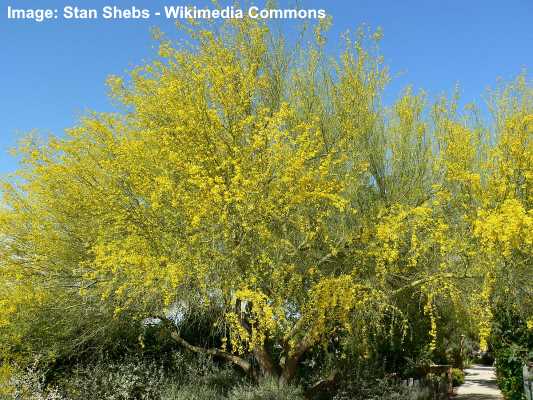
The blue palo verde is a small to medium-sized tree with unique blue-green bark and spectacular clusters of bright yellow flowers. The tree’s identifying features are its blue-green bark, small pinnately compound leaves, and papery yellow flowers with red stamens. In spring, the tree is covered in golden yellow colors, creating a vibrant display in arid landscapes.

The blue palo verde is yellow-flowering tree native to California, Nevada, and Arizona. The tree thrives in arid climates and can tolerate drought and poor soil conditions. These growth features make it excellent for xeriscape landscapes, desert gardens, and erosion control in poor soils.
The blue paloverde is the state tree of Arizona.
Mature Size: 20 to 25 ft. (3 – 7.5 m) tall and up to 20 ft. (6 m) wide
USDA Hardiness Zones: 8 to 11
Sun: Full sun
Palo Verde (Parkinsonia aculeata)
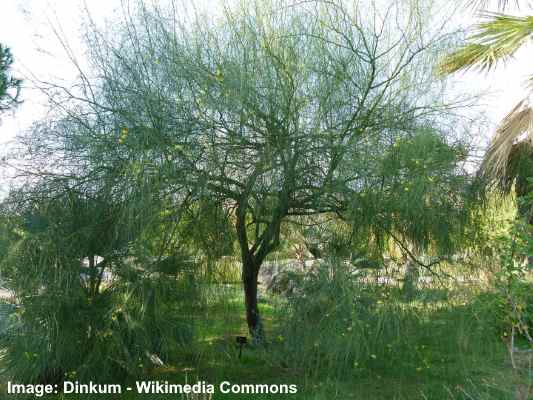
The palo verde is a small, deciduous tree that produces clusters of fragrant, orange-yellow flowers. The palo verde stands out with its unique bright-green bark and compound, bipinnate leaves. Other identifying features of this tree are its thorny branches and slender, bean-like seed pods.

Native to the southwestern United States, palo verde thrives in arid and semi-arid conditions. It is drought, salt, and heat tolerant once established and is best planted in well-drained soil. Whether used as a focal point or a shade tree, the palo verde is a valuable addition to any landscape.
Mature Size: 15 to 20 ft. (4 to 6 m)
USDA Hardiness Zones: 8-11
Sun: Full sun
Yellow Bell Orchid Tree (Bauhinia tomentosa)

The yellow bell orchid tree is known for its vibrant yellow bell-shaped flowers. The orchid-like flowers feature large pale greenish-yellow petals with a dark maroon base. Other features of this stunning ornamental tree include unique leaves with two oval lobes that look like wings and long flattened brown seed pods.
The exotic yellow flowers stand out against the tree’s dark green foliage.
Yellow orchid trees are native to tropical and subtropical regions and thrive in well-drained soil. They are drought-tolerant once established and require six to eight hours of sunlight daily. Its delightful, nectar-rich fragrant flowers attract butterflies and bees throughout the summer.
Mature Size: Up to 24 ft. (7 m) tall and wide
USDA Hardiness Zones: 9 to 11
Sun: Full sun
Yellow Buckeye (Aesculus flava)
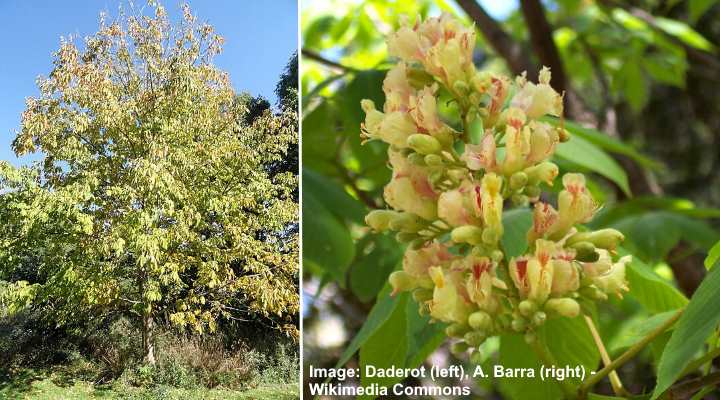
The yellow buckeye tree is an impressive deciduous tree that produces conical clusters of yellow flowers in spring and summer. The creamy-yellow tubular flowers bloom in upward-facing cone-like spikes. These contrast with the tree’s large, palmate leaves. Its fall foliage color is stunning shades of orange and golden yellow.
Their large round seed capsules are an easily identifying feature of yellow buckeye trees. The smooth, leathery capsule encases one to three shiny brown nuts. The seed balls drop in the fall and provide food for wildlife.
Due to their tall stature, yellow buckeyes are ideal shade trees in large gardens or parks. Despite being tolerant of drought, the yellow-flowering shade tree also performs well in marshy ground near ponds and streams.
Mature Size: 40 to 60 ft. (12 – 18 m) tall and 30 to 40 ft. (10 – 11 m) wide
USDA Hardiness Zones: 3 to 8
Sun: Full sun to partial shade
Cootamunda Wattle (Acacia baileyana)
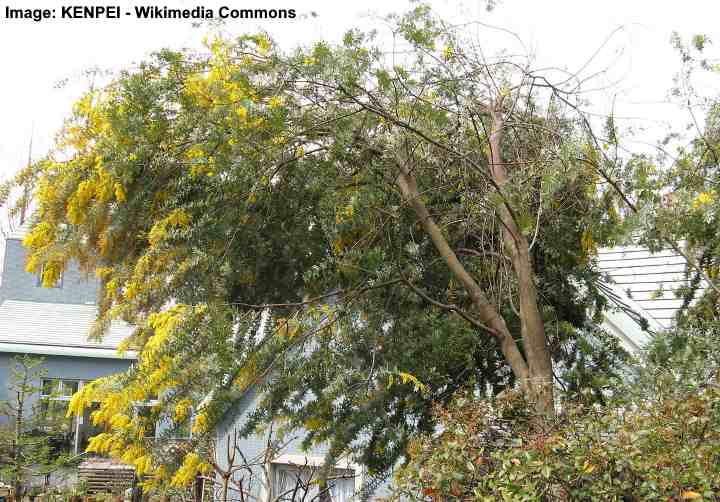
The cootamunda wattle is a spectacular ornamental evergreen thorny tree with clusters of fluffy, ball-shaped yellow flowers. The wattle tree’s identifying features are its silvery-gray fern-like leaves on weeping branches and wide-spreading canopy. Its unusual evergreen foliage and clouds of yellow spring flowers give it year-round ornamental appeal.
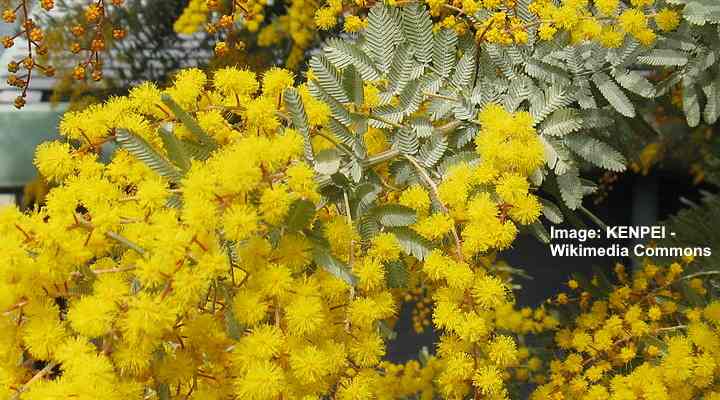
Cootamunda wattle trees are drought-tolerant and can grow in a variety of soils, including sandy, loamy, and clay soils. You can plant them as specimen trees, border plants, or lawn trees in small gardens.
Mature Size: 20 to 30 ft. (6 – 9 m) tall and wide
USDA Hardiness Zones: 9 to 11
Sun: Full sun
Long Leaf Wattle (Acacia longifolia)

Also called golden wattle, the long-leaf wattle is a yellow-flowering evergreen tree native to Australia. It produces clusters of fragrant, greenish-yellow cylindrical flower spikes measuring up to 2” (5 cm) long. After blooming, the twisted, leathery seed pods appear, measuring up to 6” (15 cm) long. The tree has long, narrow leaves that give it a graceful appearance throughout the year.
Long-leaf wattle trees are fast-growing with many landscaping uses. You can plant them in arid regions as a flowering hedge, privacy screen, or shade tree beside a patio in small gardens. The trees are also suitable for coastal gardens as they tolerate salt spray.
Mature Size: 20 to 30 ft. (6 – 9 m) tall and wide
USDA Hardiness Zones: 9 to 11
Sun: Full sun
Silver Wattle (Acacia dealbata)

The silver wattle, or the mimosa tree, is a fast-growing evergreen tree with spectacular clusters of fluffy, yellow, and fragrant flowers. The clouds of bright yellow ball-shaped flowers contrast with the tree’s feathery, silvery-blue evergreen foliage. The silver wattle blooms in late winter or early spring.
The flowers attract bees and butterflies, adding to the tree’s appeal. The silver wattle is a versatile tree that can be used as a lawn tree or a specimen plant in various landscape settings. It thrives in well-drained soil and full sun exposure. The silver wattle adds beauty and interest to any garden with its unique foliage and vibrant flowers.
Mature Size: 40 to 50 ft. (12 – 15 m) tall and wide
USDA Hardiness Zones: 9 to 11
Sun: Full sun
Golden Wattle (Acacia pycnantha)
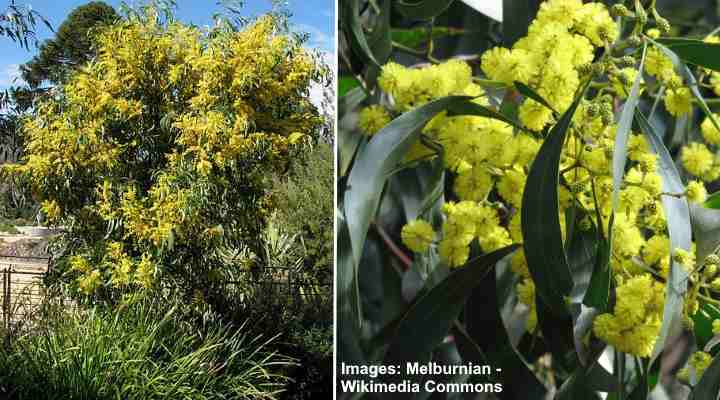
The golden wattle is a medium-sized tree with clusters of bright yellow, ball-shaped flowers that bloom in late winter and early spring. The fragrant flowers attract bees and butterflies, enhancing your garden’s ecosystem. This native Australian tree has long, thin leaves 6” (15 cm) long that are a vibrant green color.
The golden wattle is native to Australia and is the country’s national floral emblem.
The golden wattle tree is drought-tolerant and can be planted in various soil types. It is a great addition to gardens and landscapes, providing a burst of color from late winter through summer. The golden wattle’s evergreen foliage makes it ideal for a screen, windbreak, or hedge.
Mature Size: 20 to 30 ft. (6 – 9 m) tall and wide
USDA Hardiness Zones: 9 to 11
Sun: Full sun to partial shade
Sweet Acacia (Vachellia farnesiana)

The sweet acacia tree is a small tree producing clusters of puffball-like, yellow-golden flowers. Blooming in late winter and spring, the orange-yellow flowers have a sweet fragrance and attract bees, butterflies, and other pollinators. The tree is also characterized by its feathery, fern-like leaves that add to its overall ornamental appearance.
Sweet acacia trees thrive in loose, dry to medium soils with excellent drainage. They are drought-tolerant and withstand salt once established. Native to Florida, the sweet acacia is ideal for planting in coastal gardens or foundation plantings. Its thorny branches and evergreen foliage make the bushy tree an excellent security screen.
Mature Size: 15 to 20 ft. (4.5 – 6 m) tall and wide
USDA Hardiness Zones: 9 to 11
Sun: Full sun to partial shade
Golden Wreath Wattle (Acacia saligna)
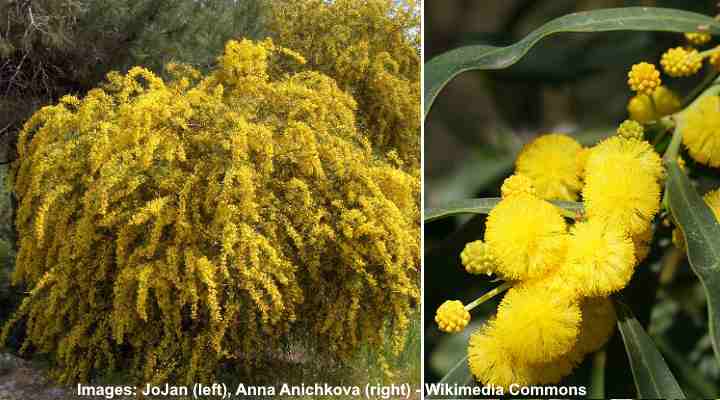
The golden wreath wattle is a small tree or large shrub known for its beautiful, bright yellow spherical flowers that emerge during spring. The flowers contrast nicely against the tree’s long, lanceolate, blue-gray leaves, which can measure up to 10 inches (25 cm). The tree produces clusters of elongated, flattened seed pods containing round, black seeds.
The golden wreath wattle is a popular ornamental tree for parks and gardens. It is fast-growing and drought tolerant, capable of withstanding high temperatures and desert-like conditions. The tree can grow in many soil types but prefers well-draining soils with sandy or loamy textures.
Mature Size: 10 to 26 ft. (3 to 8 m)
USDA Hardiness Zones: 9-11
Sun: Full sun
Goldenball Leadtree (Leucaena retusa)

The goldenball leadtree is a small, compact tree characterized by clusters of golden-yellow powder-puff flowers. Blooming from spring through fall, the tree has fluffy yellow flowers, pinnately-compound leaves, and long brown seed pods measuring 6” (15 cm). The leadtree tolerates drought but bursts into golden-yellow colors after rainfall.
Goldenball leadtrees are native to the southwestern United States and northern Mexico. The ornamental yellow-flowering trees have arching, drooping stems, making it a beautiful accent tree in a backyard garden. It is ideal for southern gardens and has a high drought, heat, and salt tolerance.
Mature Size: 20 to 25 ft. (6 – 7.6 m) tall and wide
USDA Hardiness Zones: 7 to 9
Sun: Full sun
Yellow Silk Cotton Tree (Cochlospermum religiosum)
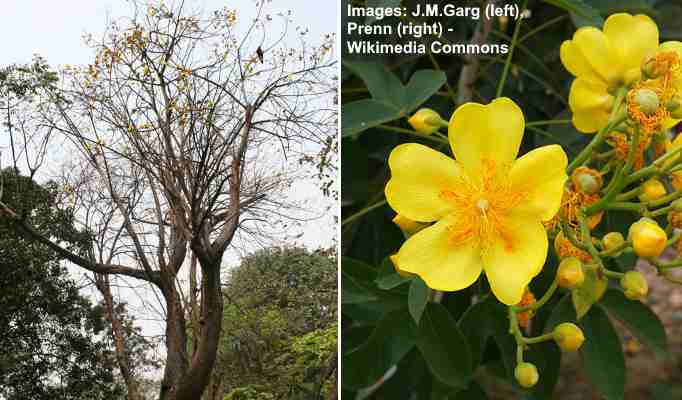
The yellow silk cotton tree is a small tropical tree that produces stunning buttercup yellow flowers. The large, showy flowers cover the tree in a beautiful display when blooming in spring and summer. Additionally, the tree has seeds covered in a fluffy cotton-like substance.
Also called the buttercup tree, the yellow silk cotton tree is ideal as an accent plant or ornamental tree in xeriscapes. Additionally, its wide, spreading canopy makes it a great shade tree to add exotic beauty to gardens in tropical and subtropical regions.
Mature Size: Up to 25 ft. (7.5 m) tall and wide
USDA Hardiness Zones: 9 to 11
Sun: Full sun
Mexican Bird of Paradise (Caesalpinia mexicana)

The Mexican bird of paradise is a small tree blooming throughout summer and fall with extravagant clusters of bright yellow flowers. The attractive flowers dangle in showy racemes measuring 6” (15 cm) long. After blooming, large, curled seed pods appear. In frost-free climates, the ornamental tree has evergreen bipinnate leaves.
Mexican bird of paradise trees are highly ornamental thanks to their fern-like foliage and showy yellow flowers. The fast-growing shrub-like tree is ideal as an accent plant or flowering tree.
Mature Size: 10 to 15 ft. (3 – 4.5 m) tall and wide
USDA Hardiness Zones: 9 to 11
Sun: Full sun
Pineapple Broom Tree (Cytisus battandieri)
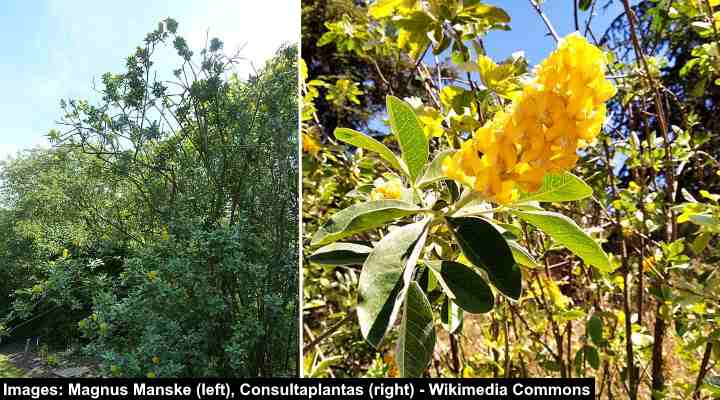
The pineapple broom tree is known for its dense clusters of pea-like yellow flowers. The attractive flowers bloom on upright cylindrical spikes and have a tasty pineapple-like fragrance. The stunning ornamental tree fills backyards with green and yellow colors when blooming in late spring and throughout summer.
Also called the Moroccan broom tree, it has gray-green, needle-like leaves that add an interesting texture to the landscape. Pineapple broom trees are drought-tolerant and can withstand poor soil conditions. Landscape uses for the yellow-flowering tree include an accent plant, flowering specimen tree, or plant to attract pollinators and wildlife.
Mature Size: Up to 13 ft. (4 m) tall and wide
USDA Hardiness Zones: 7 to 10
Sun: Full sun
Willow Pittosporum (Pittosporum phillyreoides)
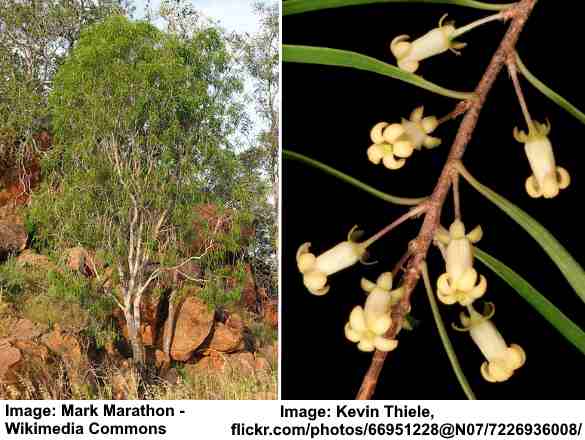
The willow pittosporum is a small multi-trunked tree that blooms in clusters of small yellow flowers. The ornamental pittosporum tree has a weeping habit, giving the tree tremendous ornamental appeal. Its narrow, linear glossy green leaves and orange ball-like fruits add to its overall beauty.
Willow pittosporum trees are versatile and can be used as a lawn tree or a specimen plant in xeric landscapes. Its upright, weeping habit makes it perfect for planting in gardens with limited space or tight corners. Also, its fragrant yellow flowers attract bees and butterflies.
Mature Size: 20 to 30 ft. (3 – 9 m) tall and wide
USDA Hardiness Zones: 7 to 11
Sun: Full sun
Silver Linden (Tilia tomentosa)

The silver linden tree is known for its shimmering foliage and fragrant clusters of creamy-white to pale-yellow flowers. The large deciduous tree has a pyramidal growth habit and is covered in drooping clusters of spring flowers. Some of its attractive features are its heart-shaped leaves that are dark green on top with silver-gray, fuzzy undersides.
Silver linden trees are easy to grow and ideal for shade or lawn trees in large landscapes. The tree’s other attractive features are its yellow foliage in the fall, silvery-gray bark, and beautiful winter silhouette. It’s also a large ornamental tree that provides habitat for birds and other wildlife.
Mature Size: 50 to 70 ft. (15 – 21 m) tall and 30 to 50 ft. (9 – 15 m) wide
USDA Hardiness Zones: 4 to 7
Sun: Full sun to partial shade
Large-Leaved Linden (Tilia platyphyllos)

The large-leaved linden is a large deciduous tree with creamy-yellow showy flower clusters, round-ovate leaves, and a broad, pyramidal crown. As a beautiful shade tree, the large-leaved linden grows up to 80 ft. (24 m) tall and 50 ft. (15 m) wide. As with all flowering linden trees, the large-leaved linden attracts bees in the summer.
The large, deciduous spreading tree grows best in moist, well-drained soil. This specimen tree is an ideal landscaping lawn, shade, or street tree. You can also train the large-leaved linden to grow as a tall privacy hedge.
Mature Size: 60 to 80 ft. (18 – 24 m) tall and 30 to 50 ft. (9 – 15 m) wide
USDA Hardiness Zones: 3 to 7
Sun: Full sun to partial shade
Verawood (Bulnesia arborea)
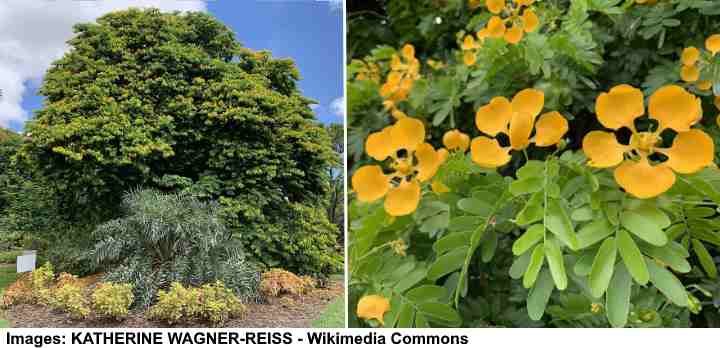
The verawood tree is a slow-growing evergreen tree prized for its brilliant yellow ornamental flowers. The eye-catching orange-yellow flowers have five round or spoon-shaped petals creating an open star shape. The small clusters of flowers contrast with fern-like foliage. As the tree matures, it develops a rounded, drooping, umbrella-like canopy, adding to its ornamental appeal.
The verawood tree is ideal for small to medium-scale landscapes, backyards, or planting near a patio for shade. The durable, hardy tree blooms for two to three months and tolerates poor soils. However, it requires careful pruning when it’s young to develop an attractive upper canopy.
Mature Size: 20 to 30 ft. (6 – 10 m) tall and wide
USDA Hardiness Zones: 10 to 12
Sun: Full sun
Chinese Flame Tree (Koelreuteria bipinnata)
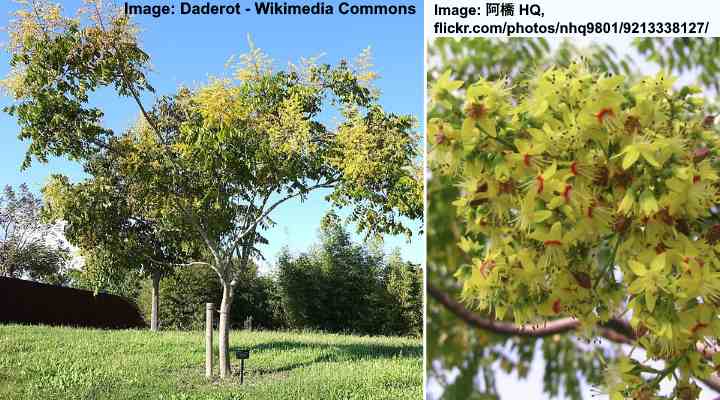
The Chinese flame tree is a beautiful ornamental deciduous tree with rich yellow flowers. Identifying features of this native Asian tree are its vase-shaped, flat-topped canopy, long pinnately-compound leaves, and clusters of rosy-pink delicate lantern-like seed capsules. However, its profusion of stunning yellow flowers makes the Chinese flame tree popular in garden landscapes.
Chinese flame trees have an all-season decorative appeal. It has stunning fall colors, masses of attractive flowers, interesting papery seed pods, and smooth, light-brown bark. Popular landscaping uses for the Chinese flame tree include planting as specimen trees or shade trees.
Mature Size: 20 to 40 ft. (6 – 12 m) tall and wide
USDA Hardiness Zones: 7 to 9
Sun: Full sun
Tipu Tree (Tipuana tipu)
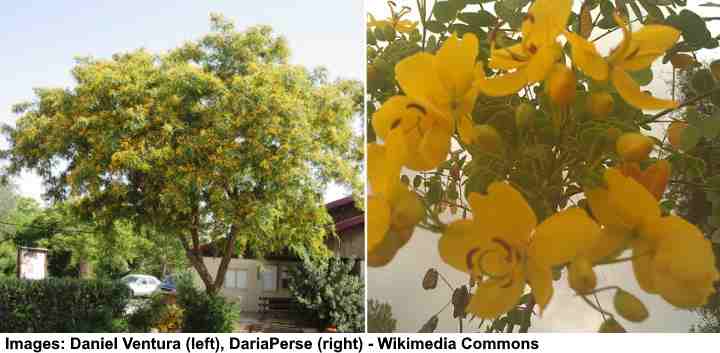
The tipu tree is an attractive shade tree with clusters of bright yellow flowers resembling small trumpets. Blooming from spring through fall, the funnel-shaped yellow flowers contrast nicely with large, pinnately compound leaves 10” (25 cm) long. In the fall, the tipu tree sheds its leaves and releases masses of winged seed pods (samaras).
Also called the pride of Bolivia or rosewood, the ornamental tree adds year-long beauty to your yard. It makes a great focal point in front yards to enhance curb appeal. Also, they are ideal as shade trees in backyards beside a patio.
Tipu trees are drought-tolerant and can withstand hot, dry conditions—ideal for desert landscapes or xeric gardens.
Mature Size: Up to 98 ft. (30 m) tall and 66 ft. (20 m) wide
USDA Hardiness Zones: 9 to 11
Sun: Full sun
Scholar Tree (Sophora japonica)
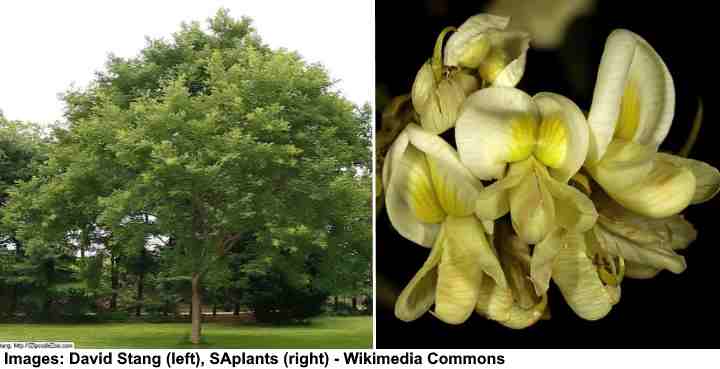
Also known as the Japanese pagoda tree, the scholar tree is prized as a shade tree for its showy, drooping clusters of greenish-white to yellow blooms. The fragrant pea-like flowers bloom in midsummer and persist for several weeks. After flowering, decorative seed pods appear as “beads on a sting.” Its compound leaves turn golden yellow in the fall.
Scholar trees are adaptable and can tolerate various soil types, including clay, loam, and sandy, well-drained soils. The ornamental tree is popular for adding shade and beauty to any landscape. It also tolerates drought and salt spray, making it suitable for planting in coastal environments.
For compact, smaller yards, choose scholar tree cultivars like the weeping ‘Pendula’ scholar tree or ‘Fastigiata’ cultivar with its narrow, upright habit.
Mature Size: 40 to 60 ft. (12 – 18 m) tall and 30 to 50 ft. (9 – 15 m) wide
USDA Hardiness Zones: 5 to 8
Sun: Full sun to partial shade
Witch Hazel (Hamamelis)
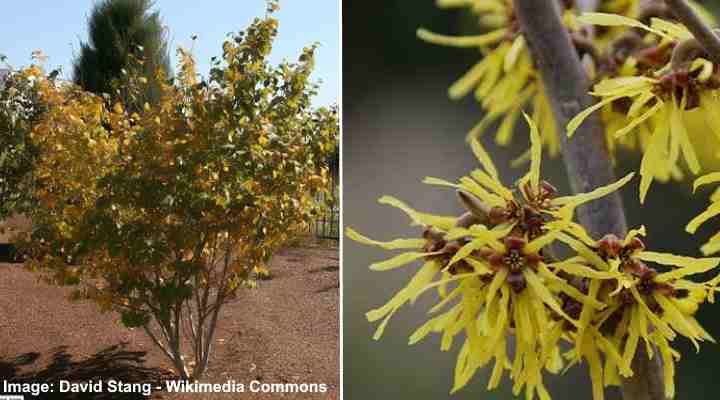
Witch hazels are small trees or large shrubs that add color during winter to barren gardens with their scented yellow flowers that have thin spindly petals. One of the ways witch hazel trees add to landscape beauty is by their colorful foliage. The tree has attractive bright green foliage in spring that turns yellowish-orange in the fall.
The short height of many witch hazel trees makes them ideal where planting space is limited. There are various witch hazel species to choose from, growing to heights of 15 to 20 ft. (4.5 – 6 m) with an equal spread.
These decorative small yellow flowering trees grow well in zones 3 – 8 and enjoy full sun and partial shade. You can use them for privacy hedges, specimen plants, or shrub borders.
Mature Size: 15 to 20 ft. (4.5 – 6 m) tall and wide
USDA Hardiness Zones: 3 to 8
Sun: Full sun to partial shade
Golden Rain Tree (Koelreuteria paniculata)
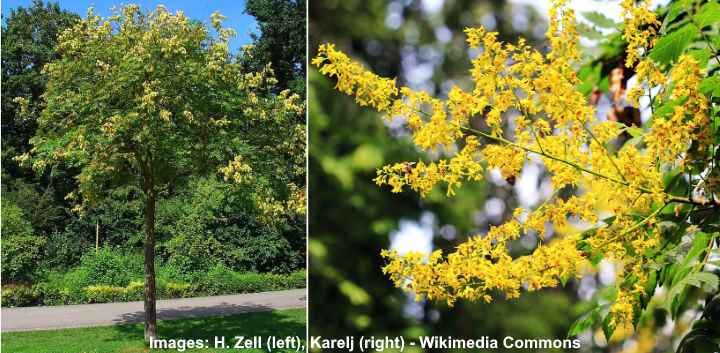
The golden rain tree is a popular ornamental tree with beautiful, four-petaled golden-yellow flowers and a broad, dome-shaped canopy. This tree is deciduous and has feathery, pinnate leaves that emerge with a pinkish hue and gradually transition to a vibrant green as they mature. It is known for its distinctive orange-brown, papery seed pods, which start off green and ripen to an attractive orange-pink during autumn.
The golden rain tree is best grown in moist, well-draining soil. It is drought- and salt-tolerant once established. Due to its stunning flowers, this tree is often grown as a focal point in any landscape. It also works well as a shade tree due to its spreading canopy.
Mature Size: 30 to 40 ft. (9 to 12 m)
USDA Hardiness Zones: 5-9
Sun: Full sun
Ylang-ylang Tree (Cananga odorata)
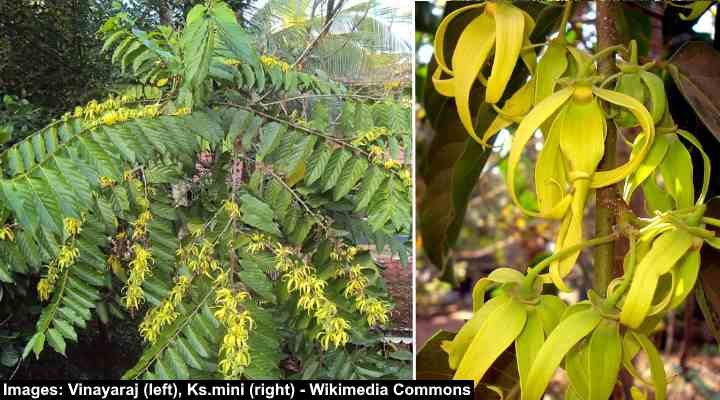
The yellow flowering ylang-ylang tree is a medium-sized tree that can be identified by its uniquely shaped, drooping yellow flowers. The tree’s highly aromatic flowers are prized for their fragrant essential oil, which is commonly used in perfumes. Other identifying features of this tree are its glossy, dark-green leaves and long, cascading branches. Another feature of this plant is its ovular, greenish-yellow fruits that turn black when ripe.
Ylang-ylang trees have a rapid growth rate of up to 5 ft. (1.5 m) per year. They prefer well-drained, neutral soil and humid, subtropical climates. Ylang-ylang trees have gained popularity as shade trees and also stand out as striking focal points in gardens and landscapes due to their lush foliage and stunning fragrance.
Mature Size: 30 to 70 ft. (9 to 21 m)
USDA Hardiness Zones: 10-12
Sun: Full sun
Frangipani (plumeria)
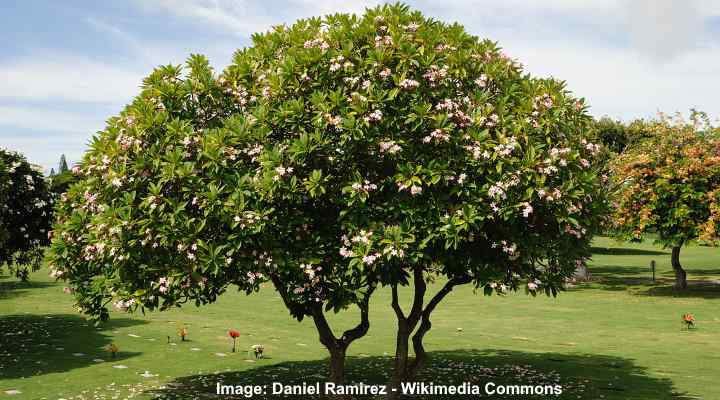
Frangipani is a family of small, deciduous trees known for their exotic, star-shaped flowers that come in a range of colors. Certain frangipani cultivars are known for producing aromatic, showy yellow or whitish-yellow flowers. Fragipani leaves are usually elliptical in shape and vibrant green. Another characteristic of frangipani are their long, fat, green pods that turn into a brownish color when they mature.

Frangipani trees thrive in well-drained soil and require full sunlight to flourish. Interestingly, they are also tolerant of bushfires due to their low flammability. You can grow any desirable cultivar as a focal point or a stunning specimen tree to add a touch of elegance and beauty to your landscape.
Mature Size: 6 and 8 ft. (1.8 – 2.4 m)
USDA Hardiness Zones: 9-12
Sun: Full sun
Read more: massive list of flowering trees with their pictures.
Related articles:
